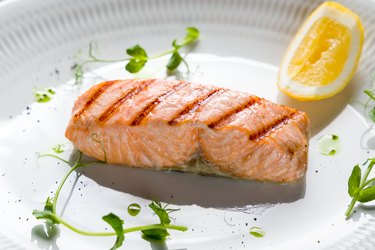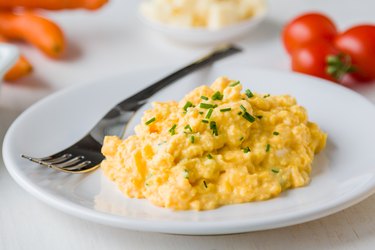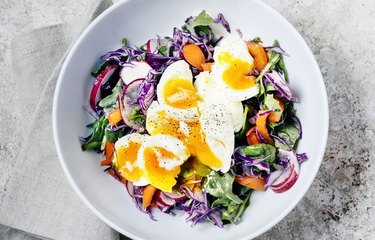
Low-residue diets limit the amount of undigestible nutrients in your GI tract. This makes it easier for your digestive system to heal in the event of surgery, treatments like radiation or conditions like inflammatory bowel disease. But what should you add to your low-residue diet foods list?
First, the basics: Fiber is the part of fruits, vegetables and grains that are not digested by the body, according to the Mayo Clinic. And while this nutrient is important for overall digestive health, it can be hard for your body to break down — especially if your digestive tract is already impaired.
Video of the Day
Video of the Day
Enter the low-fiber, low-residue diet. But what is considered low fiber, exactly? A typical low-residue diet contains 10 to 15 grams of fiber per day (compared to the 2020-2025 Dietary Guidelines for Americans-recommended 22 to 34 grams per day for people without digestive concerns), per the U.S. National Library of Medicine (NLM). This eases strain on your digestive system to better support any healing that needs to occur.
To help you make the most of this eating plan, here's a low-residue diet foods list to reference as you make your low-fiber recipes.
Tip
Only follow a low-residue, low-fiber diet if your doctor recommends it, per the NLM. This kind of eating plan can be restrictive, so follow their instructions for how to do it safely.
1. Dairy Products
First on the low-residue foods list: Dairy products. That's right, cheese is low-fiber, according to the NLM. Other milk products to add to your list of low-fiber foods include:
- Yogurt
- Kefir
- Cottage cheese
- Milk
- Pudding
- Creamy soup
Just make sure the dairy you eat doesn't contain high-residue foods like nuts, seeds, fruits or veggies, according to the NLM.
2. Refined Grains
While whole grains are typically considered the more nutritious choice, it's best to only include processed grains on your list of low-fiber food because they're easier for your body to digest. According to the NLM, good options include:
- White bread
- White, low-fiber pasta
- Dry, low-fiber cereals like puffed rice or corn flakes
- Farina
- Crackers
Here's a good way to gauge whether to include a certain grain product on your low-fiber foods list: If it contains less than 2 grams of fiber per serving, it should be OK to eat, per the NLM.
Is Oatmeal Low-Fiber?
Short answer: No. Oatmeal is a whole grain that contains more fiber than is recommended for a low-residue diet, according to the Mayo Clinic.
3. Low-Fiber Vegetables
While many raw veggies are high in fiber, some are safe for a low-residue diet, according to the NLM. Here's what vegetables are low in fiber:
- Shredded lettuce
- Cucumbers without seeds or skin
- Zucchini
Certain well-cooked or canned vegetables are also suitable for a low-residue diet, per the NLM, such as:
- Yellow squash without seeds
- Spinach
- Pumpkin
- Eggplant
- Potatoes without skin
- Green beans
- Wax beans
- Asparagus
- Beets
- Carrots
High-Residue Food List
According to the NLM, you should steer clear of the following high-fiber foods while you're sticking to a low-residue diet:
- Beans and legumes
- Whole grains like whole-wheat bread or barley
- Raw vegetables and fruits
- Fruit and vegetable juice
- Fruit and vegetable skins
- Nuts
- Seeds
- The connective tissues of meats
4. Low-Fiber Fruits
The same goes for fruits, according to the NLM. While most fruit contains high amounts of fiber, there are certain more digestible foods, including:
- Very ripe apricots
- Bananas
- Cantaloupe
- Honeydew melon
- Watermelon
- Peaches
- Nectarines
- Plums
- Papayas
5. Meat
Meat is a safe ingredient to add to your low-residue diet foods list, according to the NLM. Take care to cook the meat until it's tender and soft, and make sure it's free of gristle.
It's also best to stick to more nutritious meat options, like skinless chicken or turkey. At the same time, avoid processed meats like deli meats, hot dogs and sausage, which can irritate your digestive system, per the NLM.
6. Fish and Seafood
Fish is another nutritious food on the low-fiber list, and is an excellent source of protein while you recover, according to the NLM. Just make sure it's cooked until tender.
You can also eat other seafood like shellfish, according to the Mayo Clinic.
7. Eggs
Next on the list of foods low in fiber: Eggs, according to the Mayo Clinic. They're high in protein and versatile, making them a tasty addition to your low-residue diet menu.
Just make sure not to add high-fiber mix-ins — like most raw veggies — to your eggs.
8. Tofu
Meat, fish and eggs aren't the only high-protein foods to add to your low-residue diet. Tofu is another nutritious option, according to the Mayo Clinic.
There are many ways to cook tofu, but per the NLM, it's best to avoid frying it while you're following a low-residue diet.
9. Nut Butter
While eating nuts plain can be difficult on your digestive system, nut butters are safe to include in a low-residue diet, according to the NLM.
Just make sure to pick smooth nut butters only, as chunks of whole nuts can be tough for your body to break down.
10. Oils
Beneficial sources of fat are also OK to include on your list of low-fiber foods, and oils are a rich source of the nutrient, according to the NLM. Stick to plant-based oils like:
- Olive oil
- Avocado oil
- Flaxseed oil
- Walnut oil
- Sesame oil
- Canola oil
Was this article helpful?
150 Characters Max
0/150
Thank you for sharing!
Thank you for your feedback!


